Report on Self-Directed Recovery and Collaborative Relationships
VerifiedAdded on 2021/02/21
|11
|3745
|287
Report
AI Summary
This report delves into the concept of self-directed recovery within the context of mental health, particularly focusing on individuals with borderline personality disorder. It examines the principles of recovery, emphasizing the importance of a collaborative approach that empowers individuals to take control of their lives. The report uses a case study of Sophie to illustrate these principles, highlighting various therapeutic interventions, such as psychotherapy (including Dialectical Behavior Therapy, Schema-focused therapy, and others), and the role of medication in managing symptoms. Furthermore, it explores strategies for inviting information sharing, especially in cases where individuals are unable to communicate verbally, and emphasizes the need to define and confirm collaborative relationships between patients and caregivers. The report underscores the significance of fostering hope, dignity, and respect, while also evaluating the recovery process to ensure effective outcomes.
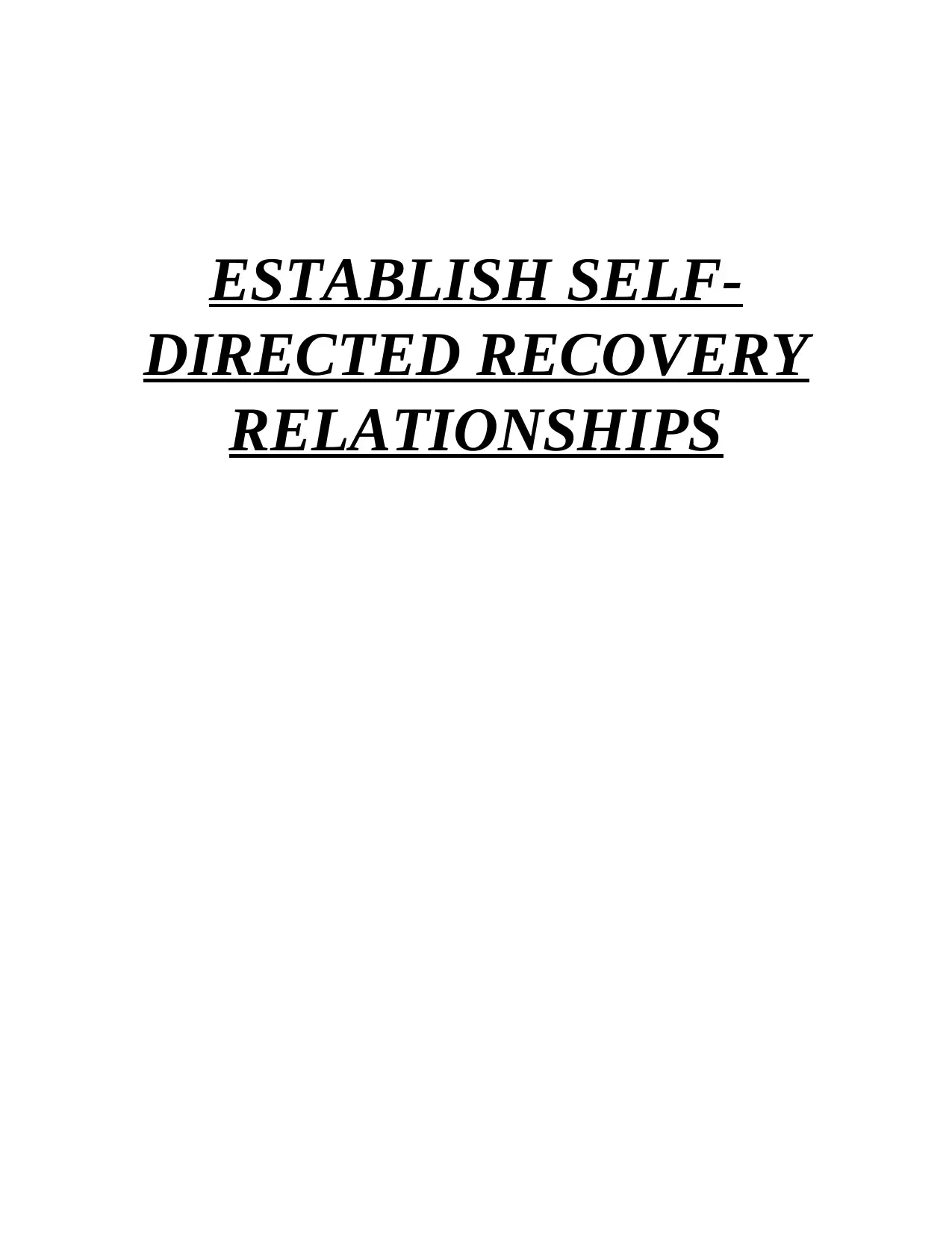
ESTABLISH SELF-
DIRECTED RECOVERY
RELATIONSHIPS
DIRECTED RECOVERY
RELATIONSHIPS
Paraphrase This Document
Need a fresh take? Get an instant paraphrase of this document with our AI Paraphraser
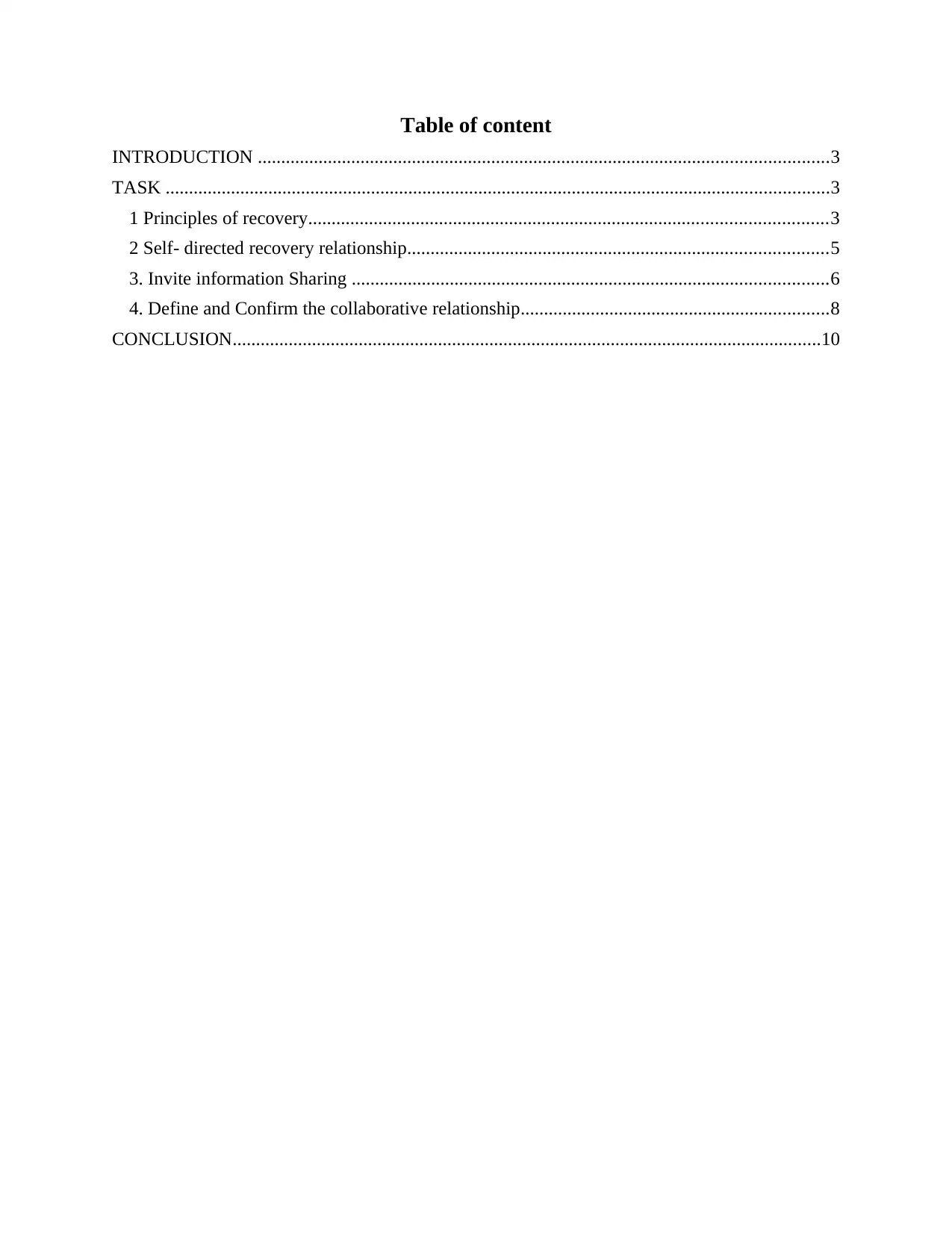
Table of content
INTRODUCTION ..........................................................................................................................3
TASK ..............................................................................................................................................3
1 Principles of recovery...............................................................................................................3
2 Self- directed recovery relationship..........................................................................................5
3. Invite information Sharing ......................................................................................................6
4. Define and Confirm the collaborative relationship..................................................................8
CONCLUSION..............................................................................................................................10
INTRODUCTION ..........................................................................................................................3
TASK ..............................................................................................................................................3
1 Principles of recovery...............................................................................................................3
2 Self- directed recovery relationship..........................................................................................5
3. Invite information Sharing ......................................................................................................6
4. Define and Confirm the collaborative relationship..................................................................8
CONCLUSION..............................................................................................................................10
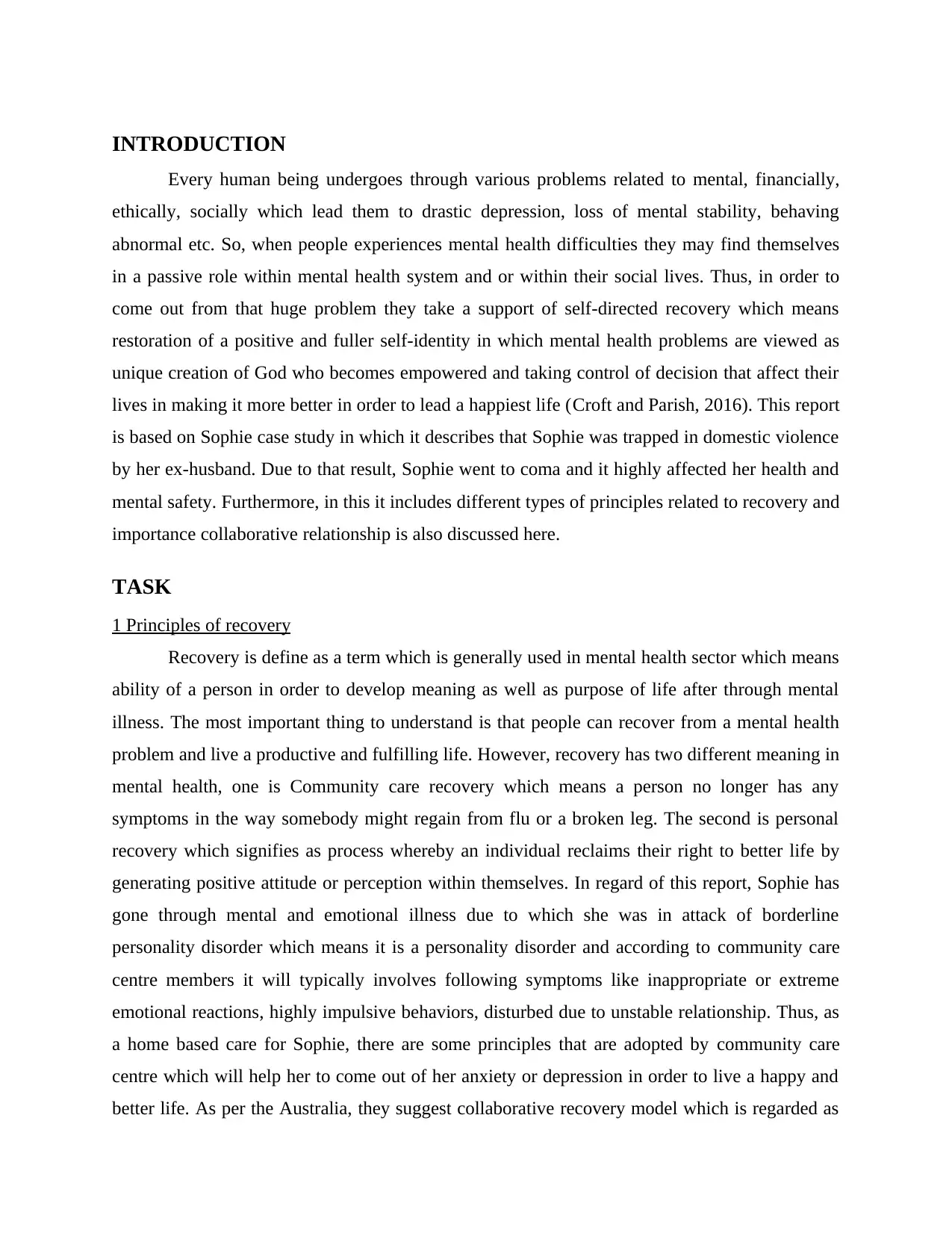
INTRODUCTION
Every human being undergoes through various problems related to mental, financially,
ethically, socially which lead them to drastic depression, loss of mental stability, behaving
abnormal etc. So, when people experiences mental health difficulties they may find themselves
in a passive role within mental health system and or within their social lives. Thus, in order to
come out from that huge problem they take a support of self-directed recovery which means
restoration of a positive and fuller self-identity in which mental health problems are viewed as
unique creation of God who becomes empowered and taking control of decision that affect their
lives in making it more better in order to lead a happiest life (Croft and Parish, 2016). This report
is based on Sophie case study in which it describes that Sophie was trapped in domestic violence
by her ex-husband. Due to that result, Sophie went to coma and it highly affected her health and
mental safety. Furthermore, in this it includes different types of principles related to recovery and
importance collaborative relationship is also discussed here.
TASK
1 Principles of recovery
Recovery is define as a term which is generally used in mental health sector which means
ability of a person in order to develop meaning as well as purpose of life after through mental
illness. The most important thing to understand is that people can recover from a mental health
problem and live a productive and fulfilling life. However, recovery has two different meaning in
mental health, one is Community care recovery which means a person no longer has any
symptoms in the way somebody might regain from flu or a broken leg. The second is personal
recovery which signifies as process whereby an individual reclaims their right to better life by
generating positive attitude or perception within themselves. In regard of this report, Sophie has
gone through mental and emotional illness due to which she was in attack of borderline
personality disorder which means it is a personality disorder and according to community care
centre members it will typically involves following symptoms like inappropriate or extreme
emotional reactions, highly impulsive behaviors, disturbed due to unstable relationship. Thus, as
a home based care for Sophie, there are some principles that are adopted by community care
centre which will help her to come out of her anxiety or depression in order to live a happy and
better life. As per the Australia, they suggest collaborative recovery model which is regarded as
Every human being undergoes through various problems related to mental, financially,
ethically, socially which lead them to drastic depression, loss of mental stability, behaving
abnormal etc. So, when people experiences mental health difficulties they may find themselves
in a passive role within mental health system and or within their social lives. Thus, in order to
come out from that huge problem they take a support of self-directed recovery which means
restoration of a positive and fuller self-identity in which mental health problems are viewed as
unique creation of God who becomes empowered and taking control of decision that affect their
lives in making it more better in order to lead a happiest life (Croft and Parish, 2016). This report
is based on Sophie case study in which it describes that Sophie was trapped in domestic violence
by her ex-husband. Due to that result, Sophie went to coma and it highly affected her health and
mental safety. Furthermore, in this it includes different types of principles related to recovery and
importance collaborative relationship is also discussed here.
TASK
1 Principles of recovery
Recovery is define as a term which is generally used in mental health sector which means
ability of a person in order to develop meaning as well as purpose of life after through mental
illness. The most important thing to understand is that people can recover from a mental health
problem and live a productive and fulfilling life. However, recovery has two different meaning in
mental health, one is Community care recovery which means a person no longer has any
symptoms in the way somebody might regain from flu or a broken leg. The second is personal
recovery which signifies as process whereby an individual reclaims their right to better life by
generating positive attitude or perception within themselves. In regard of this report, Sophie has
gone through mental and emotional illness due to which she was in attack of borderline
personality disorder which means it is a personality disorder and according to community care
centre members it will typically involves following symptoms like inappropriate or extreme
emotional reactions, highly impulsive behaviors, disturbed due to unstable relationship. Thus, as
a home based care for Sophie, there are some principles that are adopted by community care
centre which will help her to come out of her anxiety or depression in order to live a happy and
better life. As per the Australia, they suggest collaborative recovery model which is regarded as
⊘ This is a preview!⊘
Do you want full access?
Subscribe today to unlock all pages.

Trusted by 1+ million students worldwide
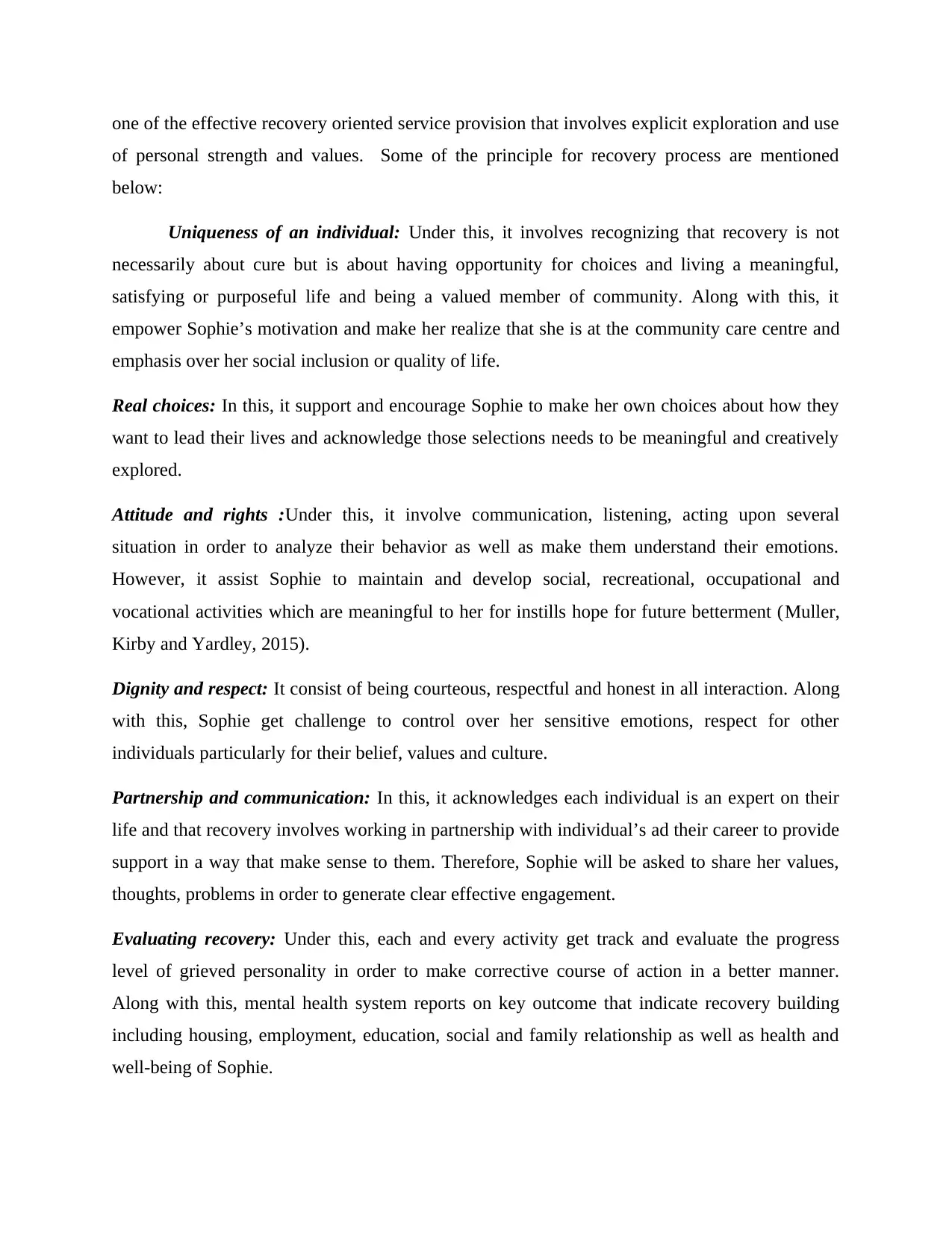
one of the effective recovery oriented service provision that involves explicit exploration and use
of personal strength and values. Some of the principle for recovery process are mentioned
below:
Uniqueness of an individual: Under this, it involves recognizing that recovery is not
necessarily about cure but is about having opportunity for choices and living a meaningful,
satisfying or purposeful life and being a valued member of community. Along with this, it
empower Sophie’s motivation and make her realize that she is at the community care centre and
emphasis over her social inclusion or quality of life.
Real choices: In this, it support and encourage Sophie to make her own choices about how they
want to lead their lives and acknowledge those selections needs to be meaningful and creatively
explored.
Attitude and rights :Under this, it involve communication, listening, acting upon several
situation in order to analyze their behavior as well as make them understand their emotions.
However, it assist Sophie to maintain and develop social, recreational, occupational and
vocational activities which are meaningful to her for instills hope for future betterment (Muller,
Kirby and Yardley, 2015).
Dignity and respect: It consist of being courteous, respectful and honest in all interaction. Along
with this, Sophie get challenge to control over her sensitive emotions, respect for other
individuals particularly for their belief, values and culture.
Partnership and communication: In this, it acknowledges each individual is an expert on their
life and that recovery involves working in partnership with individual’s ad their career to provide
support in a way that make sense to them. Therefore, Sophie will be asked to share her values,
thoughts, problems in order to generate clear effective engagement.
Evaluating recovery: Under this, each and every activity get track and evaluate the progress
level of grieved personality in order to make corrective course of action in a better manner.
Along with this, mental health system reports on key outcome that indicate recovery building
including housing, employment, education, social and family relationship as well as health and
well-being of Sophie.
of personal strength and values. Some of the principle for recovery process are mentioned
below:
Uniqueness of an individual: Under this, it involves recognizing that recovery is not
necessarily about cure but is about having opportunity for choices and living a meaningful,
satisfying or purposeful life and being a valued member of community. Along with this, it
empower Sophie’s motivation and make her realize that she is at the community care centre and
emphasis over her social inclusion or quality of life.
Real choices: In this, it support and encourage Sophie to make her own choices about how they
want to lead their lives and acknowledge those selections needs to be meaningful and creatively
explored.
Attitude and rights :Under this, it involve communication, listening, acting upon several
situation in order to analyze their behavior as well as make them understand their emotions.
However, it assist Sophie to maintain and develop social, recreational, occupational and
vocational activities which are meaningful to her for instills hope for future betterment (Muller,
Kirby and Yardley, 2015).
Dignity and respect: It consist of being courteous, respectful and honest in all interaction. Along
with this, Sophie get challenge to control over her sensitive emotions, respect for other
individuals particularly for their belief, values and culture.
Partnership and communication: In this, it acknowledges each individual is an expert on their
life and that recovery involves working in partnership with individual’s ad their career to provide
support in a way that make sense to them. Therefore, Sophie will be asked to share her values,
thoughts, problems in order to generate clear effective engagement.
Evaluating recovery: Under this, each and every activity get track and evaluate the progress
level of grieved personality in order to make corrective course of action in a better manner.
Along with this, mental health system reports on key outcome that indicate recovery building
including housing, employment, education, social and family relationship as well as health and
well-being of Sophie.
Paraphrase This Document
Need a fresh take? Get an instant paraphrase of this document with our AI Paraphraser
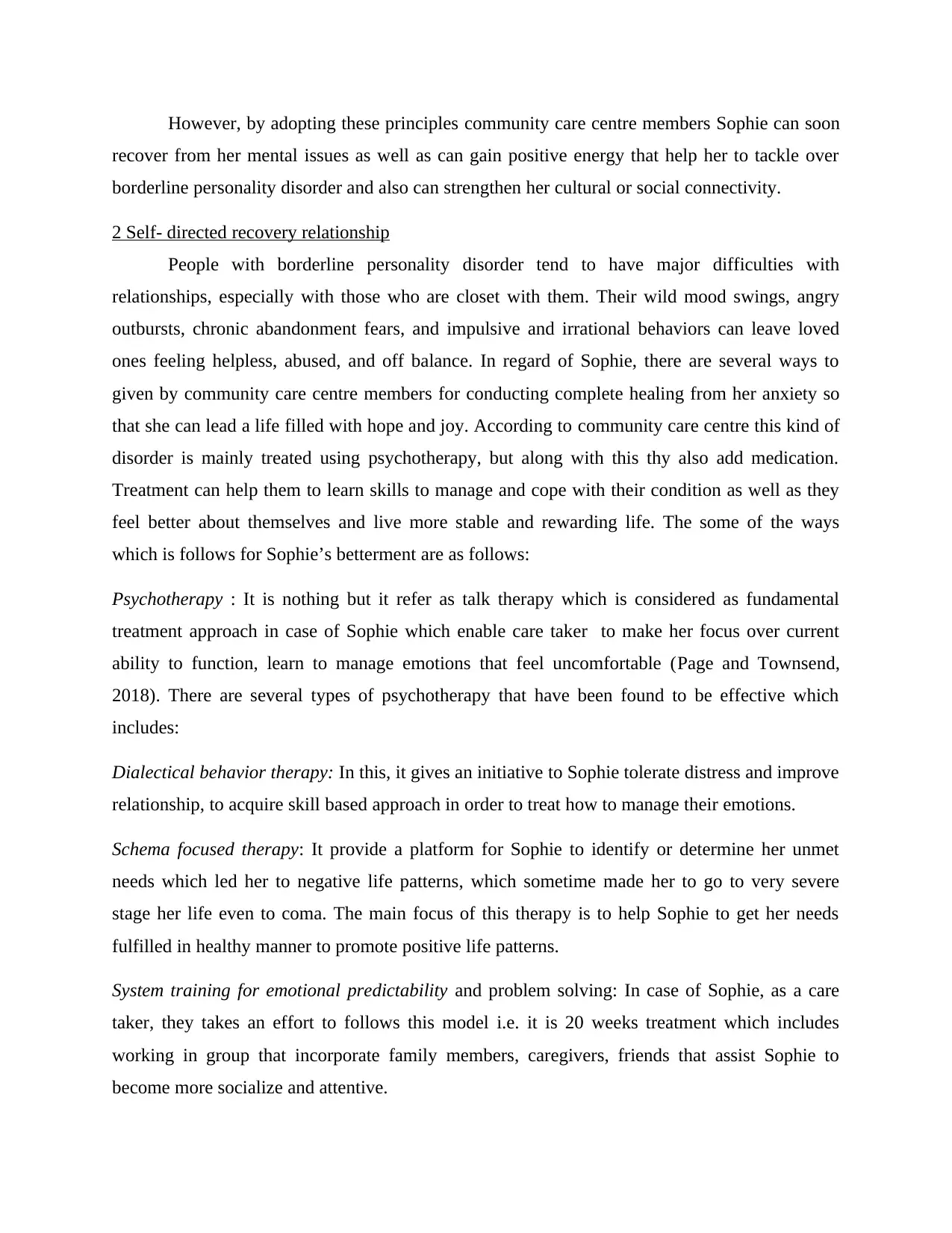
However, by adopting these principles community care centre members Sophie can soon
recover from her mental issues as well as can gain positive energy that help her to tackle over
borderline personality disorder and also can strengthen her cultural or social connectivity.
2 Self- directed recovery relationship
People with borderline personality disorder tend to have major difficulties with
relationships, especially with those who are closet with them. Their wild mood swings, angry
outbursts, chronic abandonment fears, and impulsive and irrational behaviors can leave loved
ones feeling helpless, abused, and off balance. In regard of Sophie, there are several ways to
given by community care centre members for conducting complete healing from her anxiety so
that she can lead a life filled with hope and joy. According to community care centre this kind of
disorder is mainly treated using psychotherapy, but along with this thy also add medication.
Treatment can help them to learn skills to manage and cope with their condition as well as they
feel better about themselves and live more stable and rewarding life. The some of the ways
which is follows for Sophie’s betterment are as follows:
Psychotherapy : It is nothing but it refer as talk therapy which is considered as fundamental
treatment approach in case of Sophie which enable care taker to make her focus over current
ability to function, learn to manage emotions that feel uncomfortable (Page and Townsend,
2018). There are several types of psychotherapy that have been found to be effective which
includes:
Dialectical behavior therapy: In this, it gives an initiative to Sophie tolerate distress and improve
relationship, to acquire skill based approach in order to treat how to manage their emotions.
Schema focused therapy: It provide a platform for Sophie to identify or determine her unmet
needs which led her to negative life patterns, which sometime made her to go to very severe
stage her life even to coma. The main focus of this therapy is to help Sophie to get her needs
fulfilled in healthy manner to promote positive life patterns.
System training for emotional predictability and problem solving: In case of Sophie, as a care
taker, they takes an effort to follows this model i.e. it is 20 weeks treatment which includes
working in group that incorporate family members, caregivers, friends that assist Sophie to
become more socialize and attentive.
recover from her mental issues as well as can gain positive energy that help her to tackle over
borderline personality disorder and also can strengthen her cultural or social connectivity.
2 Self- directed recovery relationship
People with borderline personality disorder tend to have major difficulties with
relationships, especially with those who are closet with them. Their wild mood swings, angry
outbursts, chronic abandonment fears, and impulsive and irrational behaviors can leave loved
ones feeling helpless, abused, and off balance. In regard of Sophie, there are several ways to
given by community care centre members for conducting complete healing from her anxiety so
that she can lead a life filled with hope and joy. According to community care centre this kind of
disorder is mainly treated using psychotherapy, but along with this thy also add medication.
Treatment can help them to learn skills to manage and cope with their condition as well as they
feel better about themselves and live more stable and rewarding life. The some of the ways
which is follows for Sophie’s betterment are as follows:
Psychotherapy : It is nothing but it refer as talk therapy which is considered as fundamental
treatment approach in case of Sophie which enable care taker to make her focus over current
ability to function, learn to manage emotions that feel uncomfortable (Page and Townsend,
2018). There are several types of psychotherapy that have been found to be effective which
includes:
Dialectical behavior therapy: In this, it gives an initiative to Sophie tolerate distress and improve
relationship, to acquire skill based approach in order to treat how to manage their emotions.
Schema focused therapy: It provide a platform for Sophie to identify or determine her unmet
needs which led her to negative life patterns, which sometime made her to go to very severe
stage her life even to coma. The main focus of this therapy is to help Sophie to get her needs
fulfilled in healthy manner to promote positive life patterns.
System training for emotional predictability and problem solving: In case of Sophie, as a care
taker, they takes an effort to follows this model i.e. it is 20 weeks treatment which includes
working in group that incorporate family members, caregivers, friends that assist Sophie to
become more socialize and attentive.
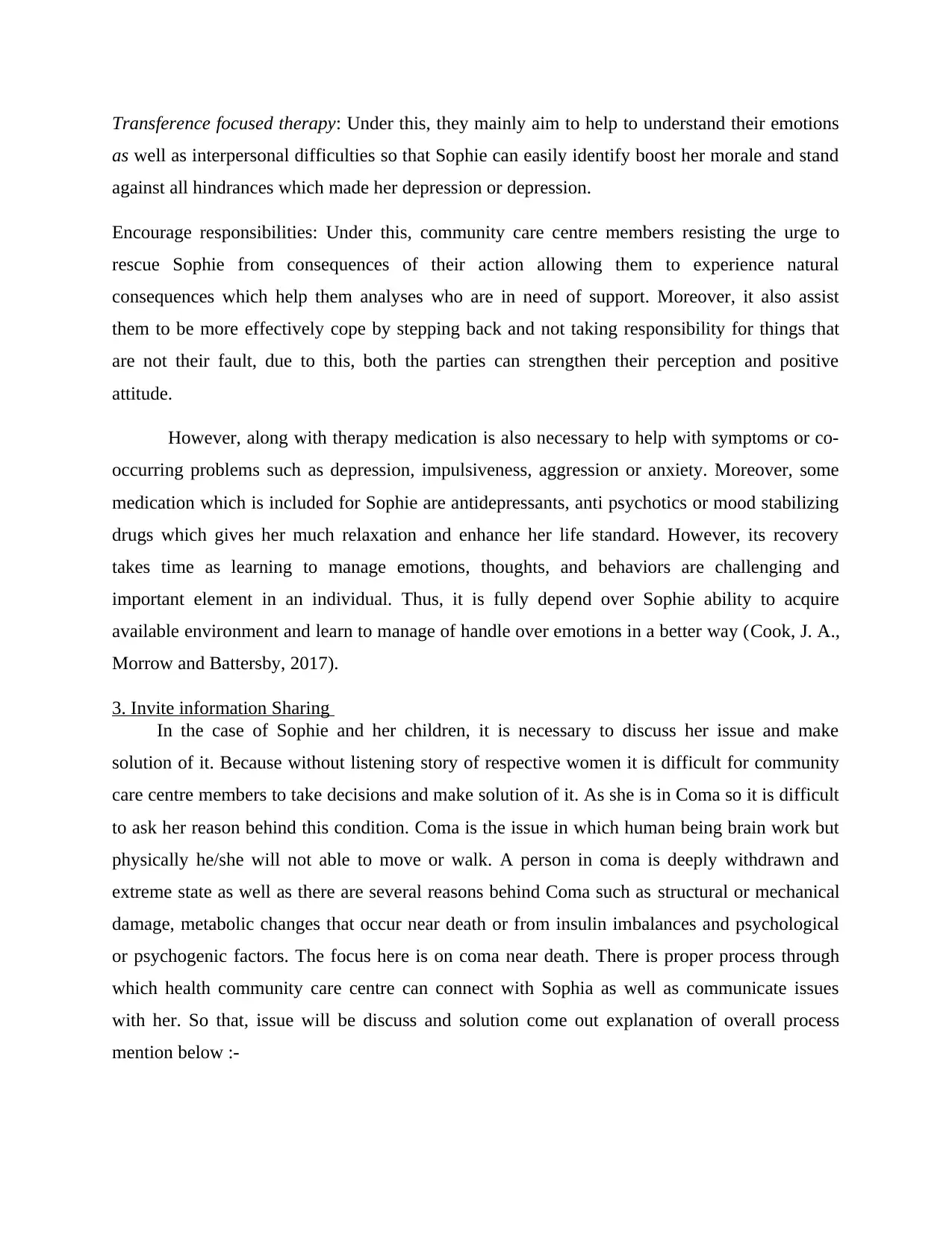
Transference focused therapy: Under this, they mainly aim to help to understand their emotions
as well as interpersonal difficulties so that Sophie can easily identify boost her morale and stand
against all hindrances which made her depression or depression.
Encourage responsibilities: Under this, community care centre members resisting the urge to
rescue Sophie from consequences of their action allowing them to experience natural
consequences which help them analyses who are in need of support. Moreover, it also assist
them to be more effectively cope by stepping back and not taking responsibility for things that
are not their fault, due to this, both the parties can strengthen their perception and positive
attitude.
However, along with therapy medication is also necessary to help with symptoms or co-
occurring problems such as depression, impulsiveness, aggression or anxiety. Moreover, some
medication which is included for Sophie are antidepressants, anti psychotics or mood stabilizing
drugs which gives her much relaxation and enhance her life standard. However, its recovery
takes time as learning to manage emotions, thoughts, and behaviors are challenging and
important element in an individual. Thus, it is fully depend over Sophie ability to acquire
available environment and learn to manage of handle over emotions in a better way (Cook, J. A.,
Morrow and Battersby, 2017).
3. Invite information Sharing
In the case of Sophie and her children, it is necessary to discuss her issue and make
solution of it. Because without listening story of respective women it is difficult for community
care centre members to take decisions and make solution of it. As she is in Coma so it is difficult
to ask her reason behind this condition. Coma is the issue in which human being brain work but
physically he/she will not able to move or walk. A person in coma is deeply withdrawn and
extreme state as well as there are several reasons behind Coma such as structural or mechanical
damage, metabolic changes that occur near death or from insulin imbalances and psychological
or psychogenic factors. The focus here is on coma near death. There is proper process through
which health community care centre can connect with Sophia as well as communicate issues
with her. So that, issue will be discuss and solution come out explanation of overall process
mention below :-
as well as interpersonal difficulties so that Sophie can easily identify boost her morale and stand
against all hindrances which made her depression or depression.
Encourage responsibilities: Under this, community care centre members resisting the urge to
rescue Sophie from consequences of their action allowing them to experience natural
consequences which help them analyses who are in need of support. Moreover, it also assist
them to be more effectively cope by stepping back and not taking responsibility for things that
are not their fault, due to this, both the parties can strengthen their perception and positive
attitude.
However, along with therapy medication is also necessary to help with symptoms or co-
occurring problems such as depression, impulsiveness, aggression or anxiety. Moreover, some
medication which is included for Sophie are antidepressants, anti psychotics or mood stabilizing
drugs which gives her much relaxation and enhance her life standard. However, its recovery
takes time as learning to manage emotions, thoughts, and behaviors are challenging and
important element in an individual. Thus, it is fully depend over Sophie ability to acquire
available environment and learn to manage of handle over emotions in a better way (Cook, J. A.,
Morrow and Battersby, 2017).
3. Invite information Sharing
In the case of Sophie and her children, it is necessary to discuss her issue and make
solution of it. Because without listening story of respective women it is difficult for community
care centre members to take decisions and make solution of it. As she is in Coma so it is difficult
to ask her reason behind this condition. Coma is the issue in which human being brain work but
physically he/she will not able to move or walk. A person in coma is deeply withdrawn and
extreme state as well as there are several reasons behind Coma such as structural or mechanical
damage, metabolic changes that occur near death or from insulin imbalances and psychological
or psychogenic factors. The focus here is on coma near death. There is proper process through
which health community care centre can connect with Sophia as well as communicate issues
with her. So that, issue will be discuss and solution come out explanation of overall process
mention below :-
⊘ This is a preview!⊘
Do you want full access?
Subscribe today to unlock all pages.

Trusted by 1+ million students worldwide
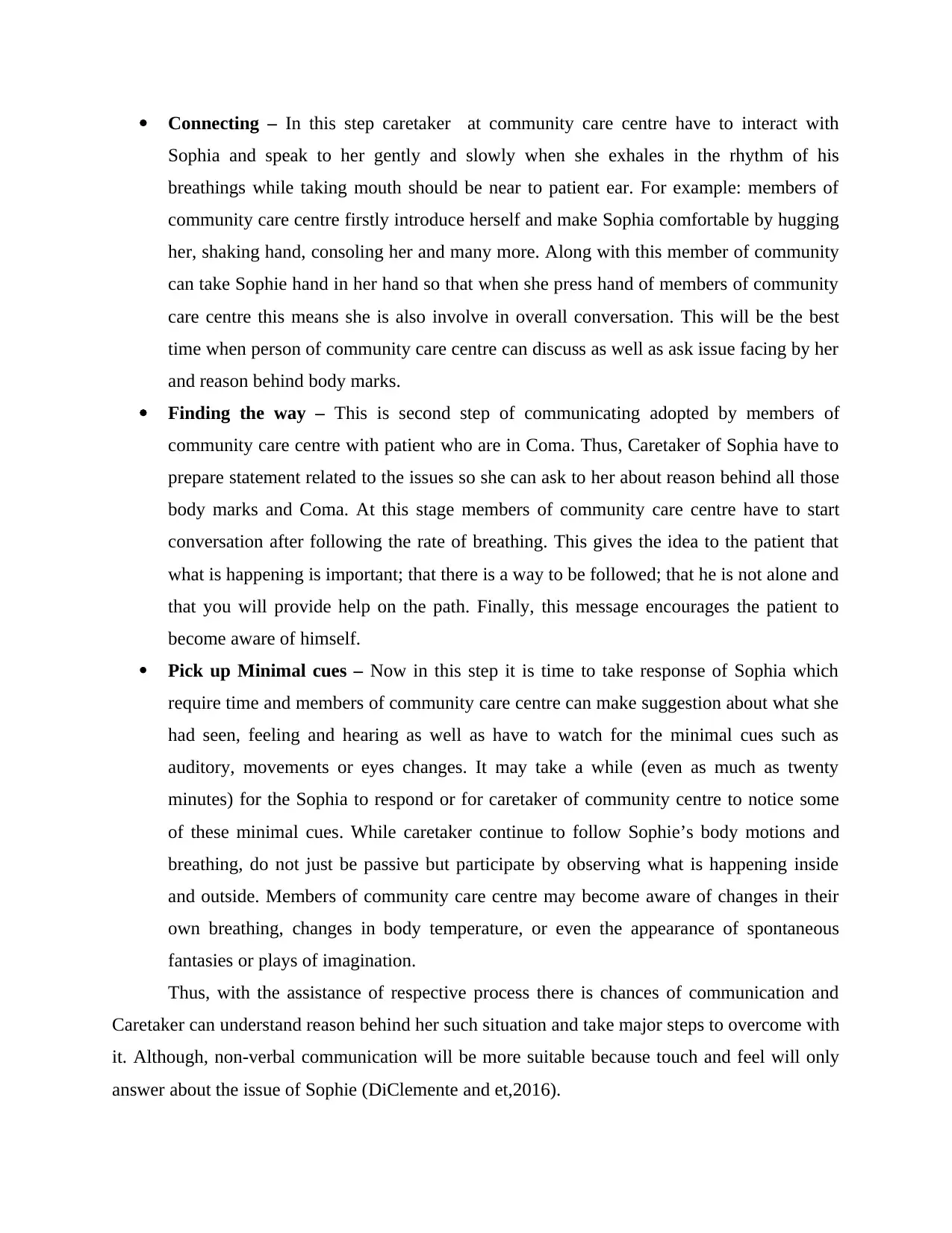
Connecting – In this step caretaker at community care centre have to interact with
Sophia and speak to her gently and slowly when she exhales in the rhythm of his
breathings while taking mouth should be near to patient ear. For example: members of
community care centre firstly introduce herself and make Sophia comfortable by hugging
her, shaking hand, consoling her and many more. Along with this member of community
can take Sophie hand in her hand so that when she press hand of members of community
care centre this means she is also involve in overall conversation. This will be the best
time when person of community care centre can discuss as well as ask issue facing by her
and reason behind body marks.
Finding the way – This is second step of communicating adopted by members of
community care centre with patient who are in Coma. Thus, Caretaker of Sophia have to
prepare statement related to the issues so she can ask to her about reason behind all those
body marks and Coma. At this stage members of community care centre have to start
conversation after following the rate of breathing. This gives the idea to the patient that
what is happening is important; that there is a way to be followed; that he is not alone and
that you will provide help on the path. Finally, this message encourages the patient to
become aware of himself.
Pick up Minimal cues – Now in this step it is time to take response of Sophia which
require time and members of community care centre can make suggestion about what she
had seen, feeling and hearing as well as have to watch for the minimal cues such as
auditory, movements or eyes changes. It may take a while (even as much as twenty
minutes) for the Sophia to respond or for caretaker of community centre to notice some
of these minimal cues. While caretaker continue to follow Sophie’s body motions and
breathing, do not just be passive but participate by observing what is happening inside
and outside. Members of community care centre may become aware of changes in their
own breathing, changes in body temperature, or even the appearance of spontaneous
fantasies or plays of imagination.
Thus, with the assistance of respective process there is chances of communication and
Caretaker can understand reason behind her such situation and take major steps to overcome with
it. Although, non-verbal communication will be more suitable because touch and feel will only
answer about the issue of Sophie (DiClemente and et,2016).
Sophia and speak to her gently and slowly when she exhales in the rhythm of his
breathings while taking mouth should be near to patient ear. For example: members of
community care centre firstly introduce herself and make Sophia comfortable by hugging
her, shaking hand, consoling her and many more. Along with this member of community
can take Sophie hand in her hand so that when she press hand of members of community
care centre this means she is also involve in overall conversation. This will be the best
time when person of community care centre can discuss as well as ask issue facing by her
and reason behind body marks.
Finding the way – This is second step of communicating adopted by members of
community care centre with patient who are in Coma. Thus, Caretaker of Sophia have to
prepare statement related to the issues so she can ask to her about reason behind all those
body marks and Coma. At this stage members of community care centre have to start
conversation after following the rate of breathing. This gives the idea to the patient that
what is happening is important; that there is a way to be followed; that he is not alone and
that you will provide help on the path. Finally, this message encourages the patient to
become aware of himself.
Pick up Minimal cues – Now in this step it is time to take response of Sophia which
require time and members of community care centre can make suggestion about what she
had seen, feeling and hearing as well as have to watch for the minimal cues such as
auditory, movements or eyes changes. It may take a while (even as much as twenty
minutes) for the Sophia to respond or for caretaker of community centre to notice some
of these minimal cues. While caretaker continue to follow Sophie’s body motions and
breathing, do not just be passive but participate by observing what is happening inside
and outside. Members of community care centre may become aware of changes in their
own breathing, changes in body temperature, or even the appearance of spontaneous
fantasies or plays of imagination.
Thus, with the assistance of respective process there is chances of communication and
Caretaker can understand reason behind her such situation and take major steps to overcome with
it. Although, non-verbal communication will be more suitable because touch and feel will only
answer about the issue of Sophie (DiClemente and et,2016).
Paraphrase This Document
Need a fresh take? Get an instant paraphrase of this document with our AI Paraphraser
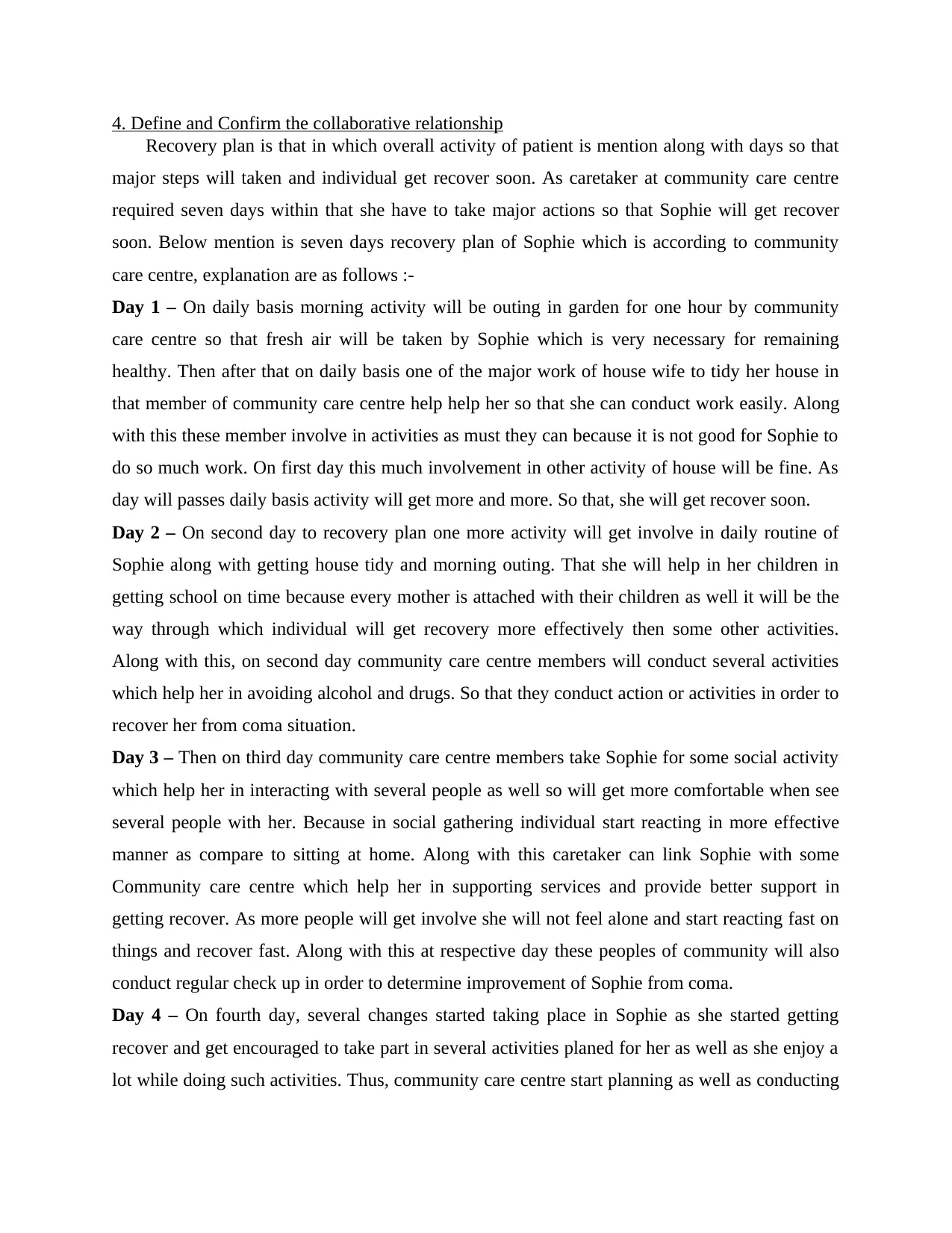
4. Define and Confirm the collaborative relationship
Recovery plan is that in which overall activity of patient is mention along with days so that
major steps will taken and individual get recover soon. As caretaker at community care centre
required seven days within that she have to take major actions so that Sophie will get recover
soon. Below mention is seven days recovery plan of Sophie which is according to community
care centre, explanation are as follows :-
Day 1 – On daily basis morning activity will be outing in garden for one hour by community
care centre so that fresh air will be taken by Sophie which is very necessary for remaining
healthy. Then after that on daily basis one of the major work of house wife to tidy her house in
that member of community care centre help help her so that she can conduct work easily. Along
with this these member involve in activities as must they can because it is not good for Sophie to
do so much work. On first day this much involvement in other activity of house will be fine. As
day will passes daily basis activity will get more and more. So that, she will get recover soon.
Day 2 – On second day to recovery plan one more activity will get involve in daily routine of
Sophie along with getting house tidy and morning outing. That she will help in her children in
getting school on time because every mother is attached with their children as well it will be the
way through which individual will get recovery more effectively then some other activities.
Along with this, on second day community care centre members will conduct several activities
which help her in avoiding alcohol and drugs. So that they conduct action or activities in order to
recover her from coma situation.
Day 3 – Then on third day community care centre members take Sophie for some social activity
which help her in interacting with several people as well so will get more comfortable when see
several people with her. Because in social gathering individual start reacting in more effective
manner as compare to sitting at home. Along with this caretaker can link Sophie with some
Community care centre which help her in supporting services and provide better support in
getting recover. As more people will get involve she will not feel alone and start reacting fast on
things and recover fast. Along with this at respective day these peoples of community will also
conduct regular check up in order to determine improvement of Sophie from coma.
Day 4 – On fourth day, several changes started taking place in Sophie as she started getting
recover and get encouraged to take part in several activities planed for her as well as she enjoy a
lot while doing such activities. Thus, community care centre start planning as well as conducting
Recovery plan is that in which overall activity of patient is mention along with days so that
major steps will taken and individual get recover soon. As caretaker at community care centre
required seven days within that she have to take major actions so that Sophie will get recover
soon. Below mention is seven days recovery plan of Sophie which is according to community
care centre, explanation are as follows :-
Day 1 – On daily basis morning activity will be outing in garden for one hour by community
care centre so that fresh air will be taken by Sophie which is very necessary for remaining
healthy. Then after that on daily basis one of the major work of house wife to tidy her house in
that member of community care centre help help her so that she can conduct work easily. Along
with this these member involve in activities as must they can because it is not good for Sophie to
do so much work. On first day this much involvement in other activity of house will be fine. As
day will passes daily basis activity will get more and more. So that, she will get recover soon.
Day 2 – On second day to recovery plan one more activity will get involve in daily routine of
Sophie along with getting house tidy and morning outing. That she will help in her children in
getting school on time because every mother is attached with their children as well it will be the
way through which individual will get recovery more effectively then some other activities.
Along with this, on second day community care centre members will conduct several activities
which help her in avoiding alcohol and drugs. So that they conduct action or activities in order to
recover her from coma situation.
Day 3 – Then on third day community care centre members take Sophie for some social activity
which help her in interacting with several people as well so will get more comfortable when see
several people with her. Because in social gathering individual start reacting in more effective
manner as compare to sitting at home. Along with this caretaker can link Sophie with some
Community care centre which help her in supporting services and provide better support in
getting recover. As more people will get involve she will not feel alone and start reacting fast on
things and recover fast. Along with this at respective day these peoples of community will also
conduct regular check up in order to determine improvement of Sophie from coma.
Day 4 – On fourth day, several changes started taking place in Sophie as she started getting
recover and get encouraged to take part in several activities planed for her as well as she enjoy a
lot while doing such activities. Thus, community care centre start planning as well as conducting
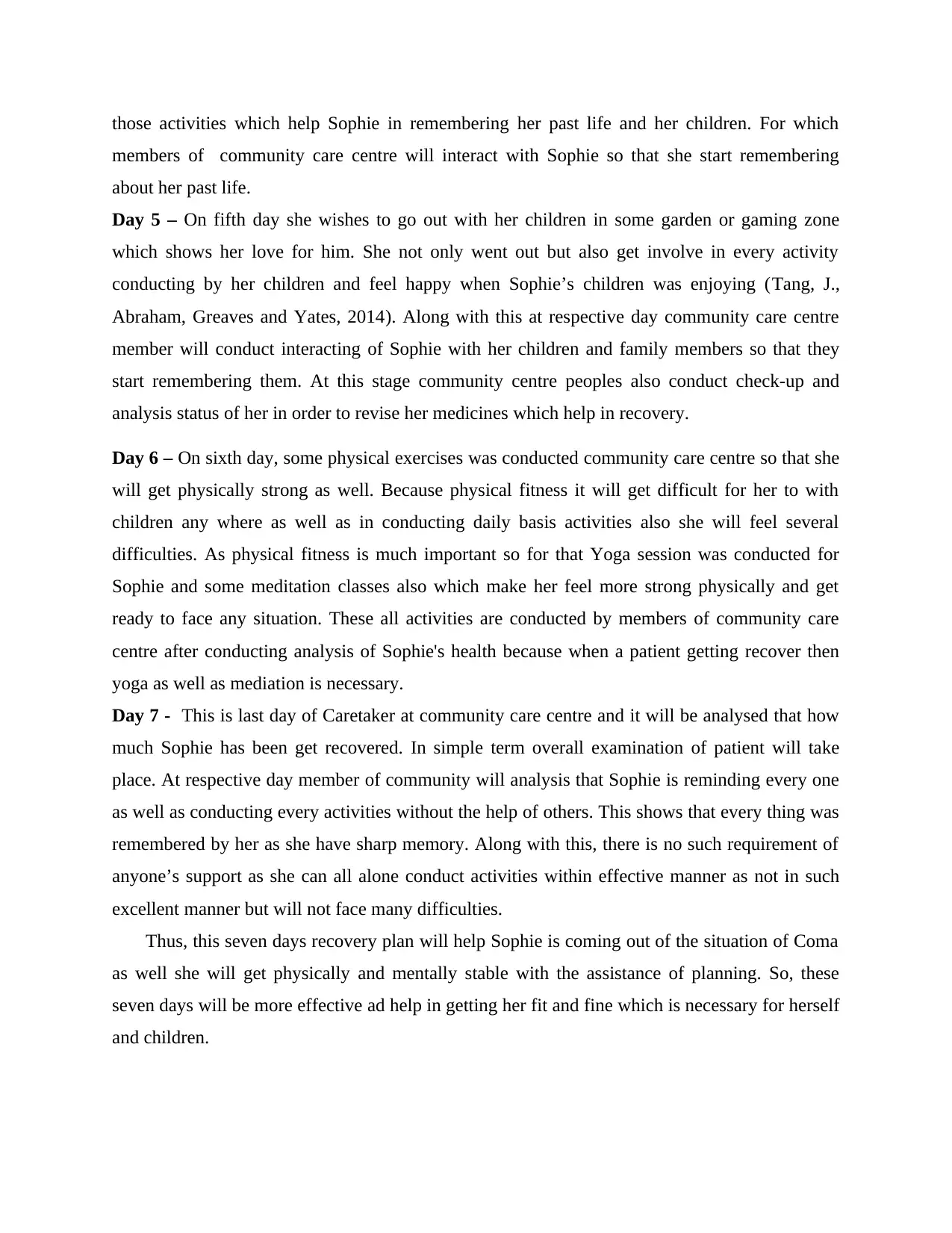
those activities which help Sophie in remembering her past life and her children. For which
members of community care centre will interact with Sophie so that she start remembering
about her past life.
Day 5 – On fifth day she wishes to go out with her children in some garden or gaming zone
which shows her love for him. She not only went out but also get involve in every activity
conducting by her children and feel happy when Sophie’s children was enjoying (Tang, J.,
Abraham, Greaves and Yates, 2014). Along with this at respective day community care centre
member will conduct interacting of Sophie with her children and family members so that they
start remembering them. At this stage community centre peoples also conduct check-up and
analysis status of her in order to revise her medicines which help in recovery.
Day 6 – On sixth day, some physical exercises was conducted community care centre so that she
will get physically strong as well. Because physical fitness it will get difficult for her to with
children any where as well as in conducting daily basis activities also she will feel several
difficulties. As physical fitness is much important so for that Yoga session was conducted for
Sophie and some meditation classes also which make her feel more strong physically and get
ready to face any situation. These all activities are conducted by members of community care
centre after conducting analysis of Sophie's health because when a patient getting recover then
yoga as well as mediation is necessary.
Day 7 - This is last day of Caretaker at community care centre and it will be analysed that how
much Sophie has been get recovered. In simple term overall examination of patient will take
place. At respective day member of community will analysis that Sophie is reminding every one
as well as conducting every activities without the help of others. This shows that every thing was
remembered by her as she have sharp memory. Along with this, there is no such requirement of
anyone’s support as she can all alone conduct activities within effective manner as not in such
excellent manner but will not face many difficulties.
Thus, this seven days recovery plan will help Sophie is coming out of the situation of Coma
as well she will get physically and mentally stable with the assistance of planning. So, these
seven days will be more effective ad help in getting her fit and fine which is necessary for herself
and children.
members of community care centre will interact with Sophie so that she start remembering
about her past life.
Day 5 – On fifth day she wishes to go out with her children in some garden or gaming zone
which shows her love for him. She not only went out but also get involve in every activity
conducting by her children and feel happy when Sophie’s children was enjoying (Tang, J.,
Abraham, Greaves and Yates, 2014). Along with this at respective day community care centre
member will conduct interacting of Sophie with her children and family members so that they
start remembering them. At this stage community centre peoples also conduct check-up and
analysis status of her in order to revise her medicines which help in recovery.
Day 6 – On sixth day, some physical exercises was conducted community care centre so that she
will get physically strong as well. Because physical fitness it will get difficult for her to with
children any where as well as in conducting daily basis activities also she will feel several
difficulties. As physical fitness is much important so for that Yoga session was conducted for
Sophie and some meditation classes also which make her feel more strong physically and get
ready to face any situation. These all activities are conducted by members of community care
centre after conducting analysis of Sophie's health because when a patient getting recover then
yoga as well as mediation is necessary.
Day 7 - This is last day of Caretaker at community care centre and it will be analysed that how
much Sophie has been get recovered. In simple term overall examination of patient will take
place. At respective day member of community will analysis that Sophie is reminding every one
as well as conducting every activities without the help of others. This shows that every thing was
remembered by her as she have sharp memory. Along with this, there is no such requirement of
anyone’s support as she can all alone conduct activities within effective manner as not in such
excellent manner but will not face many difficulties.
Thus, this seven days recovery plan will help Sophie is coming out of the situation of Coma
as well she will get physically and mentally stable with the assistance of planning. So, these
seven days will be more effective ad help in getting her fit and fine which is necessary for herself
and children.
⊘ This is a preview!⊘
Do you want full access?
Subscribe today to unlock all pages.

Trusted by 1+ million students worldwide
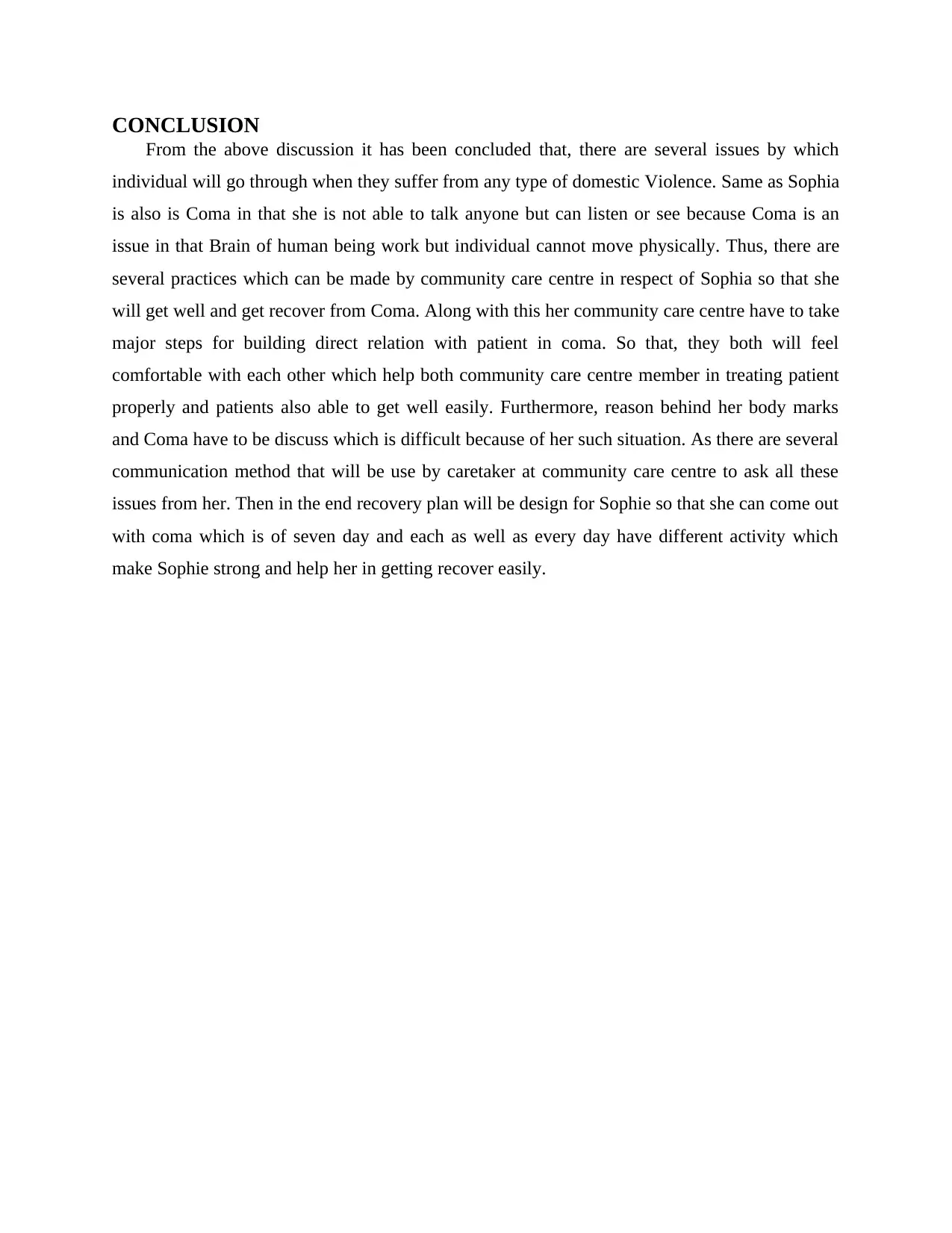
CONCLUSION
From the above discussion it has been concluded that, there are several issues by which
individual will go through when they suffer from any type of domestic Violence. Same as Sophia
is also is Coma in that she is not able to talk anyone but can listen or see because Coma is an
issue in that Brain of human being work but individual cannot move physically. Thus, there are
several practices which can be made by community care centre in respect of Sophia so that she
will get well and get recover from Coma. Along with this her community care centre have to take
major steps for building direct relation with patient in coma. So that, they both will feel
comfortable with each other which help both community care centre member in treating patient
properly and patients also able to get well easily. Furthermore, reason behind her body marks
and Coma have to be discuss which is difficult because of her such situation. As there are several
communication method that will be use by caretaker at community care centre to ask all these
issues from her. Then in the end recovery plan will be design for Sophie so that she can come out
with coma which is of seven day and each as well as every day have different activity which
make Sophie strong and help her in getting recover easily.
From the above discussion it has been concluded that, there are several issues by which
individual will go through when they suffer from any type of domestic Violence. Same as Sophia
is also is Coma in that she is not able to talk anyone but can listen or see because Coma is an
issue in that Brain of human being work but individual cannot move physically. Thus, there are
several practices which can be made by community care centre in respect of Sophia so that she
will get well and get recover from Coma. Along with this her community care centre have to take
major steps for building direct relation with patient in coma. So that, they both will feel
comfortable with each other which help both community care centre member in treating patient
properly and patients also able to get well easily. Furthermore, reason behind her body marks
and Coma have to be discuss which is difficult because of her such situation. As there are several
communication method that will be use by caretaker at community care centre to ask all these
issues from her. Then in the end recovery plan will be design for Sophie so that she can come out
with coma which is of seven day and each as well as every day have different activity which
make Sophie strong and help her in getting recover easily.
Paraphrase This Document
Need a fresh take? Get an instant paraphrase of this document with our AI Paraphraser
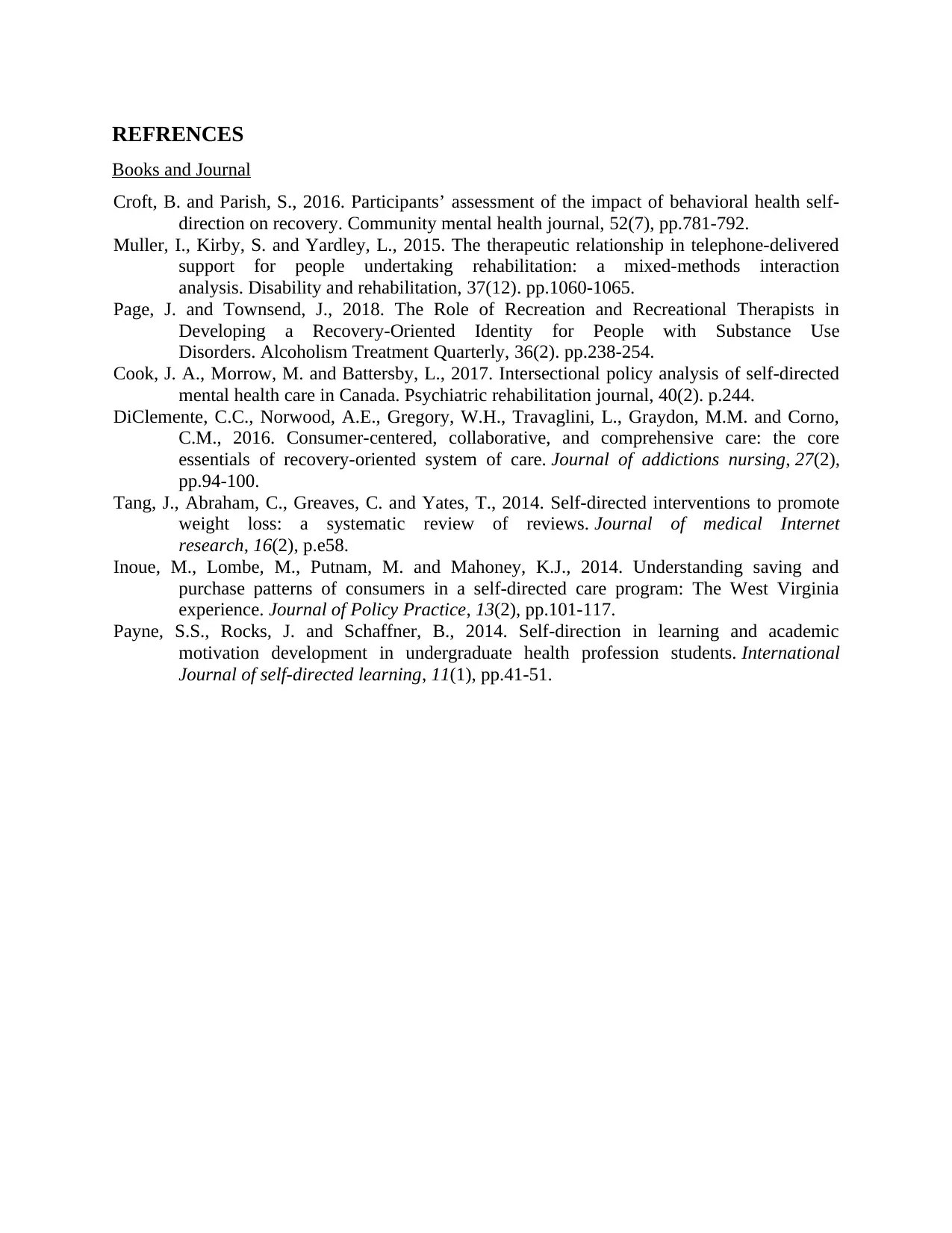
REFRENCES
Books and Journal
Croft, B. and Parish, S., 2016. Participants’ assessment of the impact of behavioral health self-
direction on recovery. Community mental health journal, 52(7), pp.781-792.
Muller, I., Kirby, S. and Yardley, L., 2015. The therapeutic relationship in telephone-delivered
support for people undertaking rehabilitation: a mixed-methods interaction
analysis. Disability and rehabilitation, 37(12). pp.1060-1065.
Page, J. and Townsend, J., 2018. The Role of Recreation and Recreational Therapists in
Developing a Recovery-Oriented Identity for People with Substance Use
Disorders. Alcoholism Treatment Quarterly, 36(2). pp.238-254.
Cook, J. A., Morrow, M. and Battersby, L., 2017. Intersectional policy analysis of self-directed
mental health care in Canada. Psychiatric rehabilitation journal, 40(2). p.244.
DiClemente, C.C., Norwood, A.E., Gregory, W.H., Travaglini, L., Graydon, M.M. and Corno,
C.M., 2016. Consumer-centered, collaborative, and comprehensive care: the core
essentials of recovery-oriented system of care. Journal of addictions nursing, 27(2),
pp.94-100.
Tang, J., Abraham, C., Greaves, C. and Yates, T., 2014. Self-directed interventions to promote
weight loss: a systematic review of reviews. Journal of medical Internet
research, 16(2), p.e58.
Inoue, M., Lombe, M., Putnam, M. and Mahoney, K.J., 2014. Understanding saving and
purchase patterns of consumers in a self-directed care program: The West Virginia
experience. Journal of Policy Practice, 13(2), pp.101-117.
Payne, S.S., Rocks, J. and Schaffner, B., 2014. Self-direction in learning and academic
motivation development in undergraduate health profession students. International
Journal of self-directed learning, 11(1), pp.41-51.
Books and Journal
Croft, B. and Parish, S., 2016. Participants’ assessment of the impact of behavioral health self-
direction on recovery. Community mental health journal, 52(7), pp.781-792.
Muller, I., Kirby, S. and Yardley, L., 2015. The therapeutic relationship in telephone-delivered
support for people undertaking rehabilitation: a mixed-methods interaction
analysis. Disability and rehabilitation, 37(12). pp.1060-1065.
Page, J. and Townsend, J., 2018. The Role of Recreation and Recreational Therapists in
Developing a Recovery-Oriented Identity for People with Substance Use
Disorders. Alcoholism Treatment Quarterly, 36(2). pp.238-254.
Cook, J. A., Morrow, M. and Battersby, L., 2017. Intersectional policy analysis of self-directed
mental health care in Canada. Psychiatric rehabilitation journal, 40(2). p.244.
DiClemente, C.C., Norwood, A.E., Gregory, W.H., Travaglini, L., Graydon, M.M. and Corno,
C.M., 2016. Consumer-centered, collaborative, and comprehensive care: the core
essentials of recovery-oriented system of care. Journal of addictions nursing, 27(2),
pp.94-100.
Tang, J., Abraham, C., Greaves, C. and Yates, T., 2014. Self-directed interventions to promote
weight loss: a systematic review of reviews. Journal of medical Internet
research, 16(2), p.e58.
Inoue, M., Lombe, M., Putnam, M. and Mahoney, K.J., 2014. Understanding saving and
purchase patterns of consumers in a self-directed care program: The West Virginia
experience. Journal of Policy Practice, 13(2), pp.101-117.
Payne, S.S., Rocks, J. and Schaffner, B., 2014. Self-direction in learning and academic
motivation development in undergraduate health profession students. International
Journal of self-directed learning, 11(1), pp.41-51.
1 out of 11
Related Documents
Your All-in-One AI-Powered Toolkit for Academic Success.
+13062052269
info@desklib.com
Available 24*7 on WhatsApp / Email
![[object Object]](/_next/static/media/star-bottom.7253800d.svg)
Unlock your academic potential
Copyright © 2020–2025 A2Z Services. All Rights Reserved. Developed and managed by ZUCOL.





